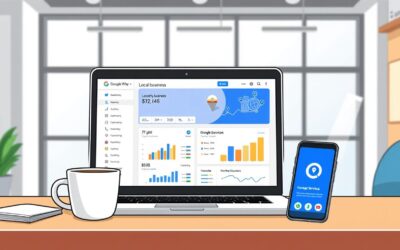Have you felt the thrill when creative minds meet? It happens around a busy conference table. Or when distant colleagues light up a shared screen with ideas. This is the essence of co-development software. It’s like a community barn raising. Everyone adds their skill, creating a strong fabric of innovation. With tools for real-time collaboration, we see teamwork evolve. Dexbytes is leading this movement, offering custom IT solutions through global teamwork.
Co-development software is the loom that brings individual threads together. It weaves a pattern of close collaboration. Everyone’s work in coding, designing, and testing joins into one vision. Imagine seamless communication, documents becoming clear plans, and meetings sparking action. This is the power of co-development.
Imagine a world where companies grow by sharing goals and successes. This is what co-development creates. Productivity and innovation soar here. This shows how working together is transformative and powerful.
Key Takeaways
- Co-development software fosters a sense of unity, empowering teams to combine expertise and achieve common objectives through real-time collaboration.
- Open-source initiatives stand as a hallmark of successful co-development, highlighting the benefits of inclusive, democratized software creation.
- With the adoption of collaborative software, organizations like Dexbytes tailor custom-tailored applications that address specific, nuanced business needs.
- Co-development platforms can dismantle traditional project bottlenecks, streamlining resource allocation and enhancing cross-functional cooperation.
- The versatility of co-development tools accommodates various roles within software projects, unifying developers, designers, and stakeholders alike.
The Rise of Co-Development Software in Agile Environments
The way teams work together in software development is changing fast. Thanks to Agile methodology, co-development in Agile frameworks is getting more popular. This has made teamwork, innovation, and delivery better across different areas, boosting both productivity and flexibility.
Understanding Co-Development in the Agile Landscape
Agile settings let teams be more flexible and work better together. With shared development platforms, many teams can work on the same project at the same time. This helps speed up the process and improves the quality through diverse contributions and constant feedback.
Important elements like shared product ownership, frequent backlog checks, and a focus on making processes better are key. These aspects help Agile co-development keep up with project changes without losing sight of the main goals.
Case Studies: Successful Agile Co-Development Projects
Linux is a great example of Agile co-development working well. Thousands of contributors from around the world work together to keep improving Linux. This shows the strength of open-source platforms powered by community cooperation and shared knowledge.
There’s solid proof that Agile methods work well in co-development. Using automated tests and time-limited sprints makes the development smoother. It ensures all features meet user needs and quality standards before they’re released.
Tools like CA Agile Central and FitNesse play a big part in managing and automating work. They help create a strong setup for Agile co-development. These tools underscore the important role of advanced technology in supporting co-development in Agile.
 Agile methods are becoming more widespread in different fields. Thus, co-development software’s importance is growing. It encourages an environment where everyone can work together and share ideas. This leads to groundbreaking innovations and solutions.
Agile methods are becoming more widespread in different fields. Thus, co-development software’s importance is growing. It encourages an environment where everyone can work together and share ideas. This leads to groundbreaking innovations and solutions.
In conclusion, the increased use of co-development software in Agile shows a move to more team-based, open, and effective software development. This change is crucial for better project results and for promoting ongoing growth and shared success in the tech world.
Why Co-Development Software Works Wonders for Team Projects
The synergy between team coding software and a joint development application changes how we manage projects. This collaborative approach makes communication smoother and boosts project flow.
Co-development software lets team members connect from different places without a hitch. Tools like GitHub and GitLab let everyone make changes and update in real time. This keeps the team on the same page with project goals and deadlines.
These tools do more than improve chat. For example, team coding software often has version control and task management. These are key to keeping the code safe and letting everyone add their part without messing up someone else’s work.
Good Developer Workflow contributes to a successful interaction between developers and software applications, encompassing elements such as efficient collaboration and communication.
- Tools like Trello and Asana fit into these systems, helping teams lay out work and assign duties easily.
- Chat platforms like Slack add to this by linking talks with tasks and code storage.
- The security in these apps protects sensitive information, controlling who can see and change data in big teams.
The fast pick-up of these team tools brings lots of pluses:
- Products get to market quicker because workflows are smoother.
- Software quality goes up as bugs are found and fixed faster.
- It sparks more new ideas and creativity by making it easier to bring in new developers and cutting training costs.
Also, things like code commits, pull requests, and keeping developers show major gains with co-development software. These boosts help not just the developers but the whole business do better.
 The smart use of joint development apps is key to running team projects well. Co-development software makes sure teams work closely together. This makes management better and results much improved.
The smart use of joint development apps is key to running team projects well. Co-development software makes sure teams work closely together. This makes management better and results much improved.
So, co-development software plays a crucial role in today’s businesses. It helps with chatting, managing projects, or keeping data safe. Being ahead in the fast market today means using these tools wisely.
Key Advantages: The Competitive Edge of Co-Development Software
In today’s fast-paced digital world, co-development software increases project management efficiency and gives businesses an edge. It speeds up the time-to-market for products. This approach offers many benefits, making development faster.
Streamlined Project Management Services
Co-development software makes managing projects smoother. It offers clear tasks and roles through tools like JIRA and Trello. Each team member focuses on what they’re best at, helping the project succeed.
Communication tools like Slack or Microsoft Teams keep everyone updated. This ensures teams are on the same page and quickly solves problems. It boosts transparency and team cohesiveness.

Cost Savings from Shared Development Efforts
Co-development software saves money by sharing resources and expertise. This reduces costs and makes big projects more affordable. It spreads development costs, helping manage budgets better.
Accelerated Time-to-Market
Speeding up product launches is a major benefit of co-development software. It uses agile methods and efficient code sharing for faster prototyping. This reduces delays, helping beat competitors to market.
Using low-code/no-code platforms and integrating tools like Jenkins cuts down on testing and deployment time. This swift process means products reach customers faster. It ensures efficiency and market readiness.
Co-development software changes project management for the better. It boosts efficiency, cuts costs, and speeds up product launches. These advantages help businesses meet today’s challenges successfully.
The Mechanics Behind Co-Development Software
Every successful group programming tool uses a well-planned co-development process. This includes careful planning and effective communication. It turns software development into a unified effort that combines different ideas towards one goal.
The core of such software lies in its organized approach. It offers features that help groups work together smoothly. This makes the co-development process seamless.
 These tools harmonize efforts with real-time updates and alerts. This keeps teams in sync on project progress. It helps avoid confusion and repetition seen in big projects.
These tools harmonize efforts with real-time updates and alerts. This keeps teams in sync on project progress. It helps avoid confusion and repetition seen in big projects.
Effective communication is vital in co-development software. It uses various channels, from chat apps to issue tracking systems. This lets team members share updates and solve problems together, no matter where they are.
| Challenge | Strategy | Outcome |
|---|---|---|
| Unclear distribution of responsibilities | Define precise tasks and roles | Streamlined operations and reduced redundancy |
| Potential for burnout | Monitor stress and allocate resources efficiently | Enhanced team wellbeing and productivity |
| Inter-team conflicts | Establish clear communication and mediation protocols | Smoother resolution processes and sustained project momentum |
Co-development tools do more than share tasks. They also share knowledge and insights. The goal is to combine individual efforts into a standout product. This shows the strength of group programming tools. They bring together various skills into one powerful force.
Real-time collaboration and tracking contributions help keep the project on track. Agile methods allow for regular updates to align with goals.
This mix of planning, doing, and communicating is key in co-development software. It lets teams around the world meet and beat their software development targets.
Essential Features That Define Effective Co-Development Software
In the world of co-development tools, some features are key for boosting team productivity and collaboration. These include an interactive coding platform, real-time collaboration, and solid project tracking. These are must-haves in today’s quick-moving development settings.
Real-Time Collaboration Capabilities
Real-time collaboration is a core aspect of co-development software. It lets team members share updates and feedback right away. GitHub and Microsoft Teams have changed how developers work together. They make coding and teamwork smooth, keeping everyone in sync through the project.
Version Control Systems and Code Sharing
Good co-development software comes with seamless version control. This is key for handling project changes while keeping everything intact. GitLab is great here, mixing code sharing with CI/CD pipelines. These features make it easier to manage different versions and changes from several contributors without issues.
Project Tracking and Resource Management
Adding project tracking tools to co-development software is vital. They help set clear tasks, track progress, and manage resources well. Tools like JIRA and Trello let teams use kanban boards and issue trackers. This keeps the project visible to all and helps in using resources wisely to meet deadlines.
These features are not just important on their own. Together, they are crucial for a winning co-development process:
| Feature | Key Benefit | Example Tools |
|---|---|---|
| Real-Time Collaboration | Immediate update and feedback capabilities | Slack, Microsoft Teams, Discord |
| Version Control | Effective management of code changes | GitHub, GitLab |
| Project Tracking | Enhanced visibility and resource allocation | JIRA, Trello |
Integrating these key features in co-development software smooths out workflow and encourages a creative, efficient environment. Leveraging these tools lets teams excel in software development. They don’t just meet industry demands; they create new success standards.
Co-Development Software and Its Integration with Diverse Programming Tools
Integración de co-development software with various programming tools changes how businesses work for the better. As programming tools are key for complex projects, their seamless integration with co-development software is crucial. This integration is vital for success in today’s fast-changing markets.
When companies use partnered software development, co-development software boosts work efficiency and project results. It enables teams, even those spread out, to work together in real time. This approach means everyone understands the project, avoiding traditional development delays. Companies with collaborative software finish projects much quicker than those using old methods.
The careful integration of tools like GitHub, GitLab, and Bitbucket with co-development software is key. This setup offers strong version control. It lets teams handle many coding tasks and updates smoothly. Adding project management and bug-tracking systems makes it easier to track progress and fix problems quickly. This is why seamless integration is praised.
| Feature | Impact on Development Speed | Impact on Collaboration |
|---|---|---|
| Real-Time Collaboration | Accelerates cycle times | Enhances communication |
| Version Control | Maintains code integrity | Facilitates concurrent development |
| CI/CD Tools Integration | Enables Continuous Deployment | Supports consistent updates |
Co-development software also boosts partnered software development. It encourages knowledge sharing and ongoing learning. This way, development settings become innovation hotspots. This often leads to better product quality. Agile teams using Scrum methods saw a 250% quality boost.
The integration of programming tools with co-development software doesn’t just offer tech flexibility. It also promotes a culture of ongoing improvement and strategic flexibility. These systems capture the agile philosophy. They support continuous integration and delivery. This is essential to keep up in the fast tech world.
Navigating Challenges: Best Practices for Co-Development Success
In our co-development journey, we must focus on both promise and challenges. Overcoming obstacles is crucial. We do this not just by expecting them, but by making them chances for growth. We can markedly better our co-development results by setting clear aims, keeping open lines for dialogue, and being agile.
Setting Clear Goals and Realistic Timelines
Success in co-development starts with clear goals. Having solid, achievable targets is key. This means knowing what success looks like and getting everyone on the same page. A smart plan for timelines boosts efficiency and satisfies stakeholders. Using tools like Git and Jira helps keep everyone aligned and on schedule.
Promoting Open Communication and Regular Check-Ins
Open communication is vital in co-development projects. Keeping everyone updated and discussing issues early ensures we’re all in sync. Using Slack and Azure DevOps helps a lot. These tools make talking across different places and cultures easier. They knock down walls and make honest chats happen.
Monitoring Progress for Agile Adjustments
Agile methods suggest we evolve and check in constantly. This lets teams tweak things based on new feedback and needs. Staying up-to-date and flexible is crucial. With Cloud and DevOps, we can stay agile. These technologies let us swiftly tackle any new hurdles.
| Factor | Challenge | Best Practice |
|---|---|---|
| Comunicación | Cultural and geographic diversity | Regular virtual meetings, use of unified communication platforms like Slack |
| Development Time | Complex integration of systems | Incremental development with Agile adjustments and Scrum frameworks |
| Cost Management | Overlapping resources and efforts | Consolidated resource planning, leveraging expertise from multiple teams |
| Innovation | Syncing different technical backgrounds | Cross-functional teams with open ideation sessions and joint problem-solving |
To wrap up, succeeding in co-development means planning well and integrating the right tools. But it’s also about being open to change. By tackling challenges head-on, making agile changes, and valuing open talk, we can reach–and even surpass–our project goals.
Real-World Examples of Co-Development Software Impact
The arrival of co-development software has changed how we create software. It highlights the essence of successful co-development and effective teamwork. We see its big impact everywhere, from small startups to big companies, across different fields.
Understanding the impact of effective keywords is like seeing how teamwork in coding brings new ideas. Take IBM and Apple working together as an example. They made new solutions for businesses, showing how teamwork with coding tools leads to big tech improvements.
Ford and Google teamed up to work on new tech for cars. This partnership shows the good in joining knowledge from different areas. It speeds up tech development, cuts down on market time, and makes products more relevant.
| Empresa | Innovation | Impact |
|---|---|---|
| IBM & Apple | Enterprise Mobility Solutions | Enhanced business applications for iOS |
| Ford & Google | Advanced Vehicle Technologies | Pioneering solutions for connected cars |
| Nokia & Ericsson | 5G Technology Development | Industry-leading network infrastructure |
Using these tools for successful co-development speeds up projects and saves money. It helps teams in different places work together well. This shows that working together can lead to much more innovation and efficiency.
Co-development is doing great in areas like telecoms and big data, too. Companies like Nokia and Ericsson share their know-how to lead in new tech. This shows the power of having common visions and goals in making big leaps in competitive fields.
Indeed, the power of co-development tools is clear in many areas. It shows that when companies team up, they can invent endless new things. It makes the process from idea to reality smoother. It proves how planning and working together helps beat usual project hurdles.
Choosing the Right Co-Development Software: A Comprehensive Guide
Choosing the right co-development software is crucial. It affects your team’s effectiveness and collaboration. Teams have different needs. Understanding these needs helps in making an informed decision. Let this guide help you consider key factors, like software scalability and security.
Understanding Your Team’s Unique Needs
Start by analyzing your team’s workflow, objectives, and challenges. Is your team working across different time zones? Are real-time collaboration tools needed, or is task management more important? Knowing what you need helps narrow down your co-development software options.
Considerations for Software Scalability and Security
In today’s business world, choosing scalable software is critical. It must grow with your team and projects without big changes or extra costs. Security is also key. As teamwork often involves sensitive info, protecting your data from unauthorized access is essential.
- Real-time collaboration: This enhances productivity and team efficiency by allowing simultaneous input and immediate feedback.
- Fewer emails and messages: The right software centralizes communication, reducing clutter and misunderstandings.
- Remote teamwork facilitation: For global teams, software that supports remote work can connect different regions effectively.
Integration capabilities are also important. Can the software integrate with tools your team already uses? How does it manage different time zones? Does it have versatile communication tools for different departments?
When looking at options, check user reviews, customization options, ease of use, and customer support quality. These factors impact user experience and how well your team adopts the software.
Enhancing collaboration and productivity without losing security or needing big changes as your team grows is the aim. This guide shows the way to do just that.
Conclusión
The co-development approach is changing the software development world. It comes from much research and real use. For instance, 54% of companies see more innovation, while 76% enjoy better quality and more reliable software. This method fits perfectly into software creation, boosting shared knowledge (68%) and resources. It also makes adjusting to quick market changes easier (82%).
Co-development’s merge with Agile methods is more than just a passing trend. It’s a smart move to keep up with the fast digital world changes. Research by Forrester and Deloitte highlights the growth of remote IT and cloud services. According to Gartner, co-development is key in making fewer mistakes and streamlining the development process.
The push for sustainable software also meets environmental and company ethics. It’s about creating advanced yet planet-friendly software. This is shown by 32% of open-source projects and 46% of company partnerships in co-development. Teams focusing on clear goals and strong security (75%) find success with this method. Co-development leads to more effective, inclusive, and green software creation. It’s proving to be an essential tool in the competitive market today.




0 comentarios